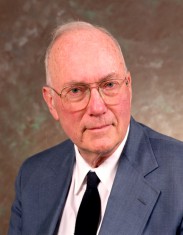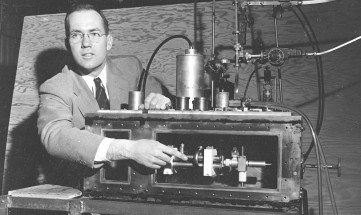Charles Hard Townes
 Charles Hard Townes was born July 28, 1915 in Greenville, South California, USA, and died on 27 January 2015 at the age of 99 years.
Charles Hard Townes was born July 28, 1915 in Greenville, South California, USA, and died on 27 January 2015 at the age of 99 years.
Townes was a talented student from childhood and in 1935, at the age of 19, he completed his bachelor studies summa cum laude at the Furman University of Liberal Arts, where he earned a Bachelor of Science degree in physics and a Bachelor of Arts in Modern Languages. From the second year at university he was fascinated by physics for its "lovely logical structure." His versatility was also demonstrated by the fact that during his studies he served as curator of the University Museum and during his summer camps he collected samples, was on a swimming team and a member of the football team and he was also one of the university newspaper editors.
He obtained his Master's degree at Duke university in 1936 and subsequently joined Caltech (California Institute of Technology), where he received his doctorate in 1939 for his work on isotope separation and nuclear spins.
 At that time, he had already been working at Bell Telephone Laboratories for 3 years. He was also involved in the development of radar systems for the Air Force durring World War II. He later built on the knowledge he gained durring this project when he worked on the development of spectroscopic methods at Columbia University, which he joined in 1948. He studied the structure of molecules, atoms and nuclei by studying the interactions of microwaves with molecules. In 1951 he began to develop the idea of an ammonia maser. The solution to how to reliably generate short waves came to Townes while he was sitting on a par bench in the spring of 1951 and he sketched it on an envelope. Three years later, his team successfully constructed a maser (acronym for microwave amplification by stimulated emission of radiation) which was able to generate and amplify microwave radiation. The first maser in Czechoslovakia was constructed in 1963 at our institute, which was then called the Institute of Radio Engineering and Electronics, by a team led by Dr. Viktor Trkal.
At that time, he had already been working at Bell Telephone Laboratories for 3 years. He was also involved in the development of radar systems for the Air Force durring World War II. He later built on the knowledge he gained durring this project when he worked on the development of spectroscopic methods at Columbia University, which he joined in 1948. He studied the structure of molecules, atoms and nuclei by studying the interactions of microwaves with molecules. In 1951 he began to develop the idea of an ammonia maser. The solution to how to reliably generate short waves came to Townes while he was sitting on a par bench in the spring of 1951 and he sketched it on an envelope. Three years later, his team successfully constructed a maser (acronym for microwave amplification by stimulated emission of radiation) which was able to generate and amplify microwave radiation. The first maser in Czechoslovakia was constructed in 1963 at our institute, which was then called the Institute of Radio Engineering and Electronics, by a team led by Dr. Viktor Trkal.
In 1958, Charles Townes and his brother-in-law Arthur Schawlow published the idea of creating an optical maser and thus greatly contributed to the invention of the laser by providing the grounds on which it was then built [Townes1958].
Here, he discovered the relationship to the limit of the width of the laser line, known as the Schawlow-Townes equation, which is now used for four-leveled lasers and is written as
where ΔνR is FWHM width of the resonance peak of the resonator, v is the laser frequency, h is Planck's constant and PL is the laser output power. This relationship states that the minimum attainable laser line width is limited by spontaneous emission which adds amplitude and phase noise to the field of the resonator every time it runs through. While the amplitude fluctuations are damped and due to a gain in saturation the amplitude always returns to its steady state, the phase fluctuations are muffled and the phase randomly fluctuates with power spectral density
resulting in the final line width ΔνL. Generally, a laser line is much wider.
However, Townes was appointed director of research for the US government at the Institute of Defense Analyses (I DA) in 1959, which slowed his efforts to build the optical device (laser) and Theodore Maiman beat him to it when he presented the first functional laser in 1960.
In 1964, he was awarded the Nobel Prize for the development of quantum electronics and for the invention of the maser, which subsequently led to the invention of thelaser.
He was head of the Columbia Radiation Laboratory and head of the Department of Physics at Columbia University. In the years 1960 - 1967 he worked at MIT (Massachusetts Institute of Technology). In 1967 he accepted the position of a professor at the University of California.
Townes himself continued to use masers and lasers in his later work in radio-astronomy, infrared astronomy and interferometry. Townes constructed an interferometer, again using lasers, which captures infrared light with three telescopes and creates high-resolution images, which could otherwise be captured only by a much more powerful telescope. This interferometer (Infrared Spatial Interferometer Array) can measure the diameters of stars that otherwise appear only as points of light in most telescopes. Charles Townes supported the use of masers and lasers in areas as diverse as the accurate measurement of time (atomic clock) and extraterrestrial communication. With the help of lasers, he and his colleages were able to be the first ones to detect complex molecules in interstellar space and they were also the first ones to measure the mass of the black hole at the center of our galaxy. His technique is still employed by today's most powerful telescopes in the world.
Charles Townes was awarded dozens of awards, medals, honorary doctorates and state awards. In 2005, Townes was awarded the Templeton Prize for his contribution to the understanding of religion. Townes won this award for his lifetime contribution to the gap between science and faith. His idea was that science seeks laws by which our universe is governed, while religiontries to understand the meaning of the universe. His paper about this topic can be found here.
According to Townes, if people want to expand their knowledge, the cannot ignore either science, nor faith because both try to find the truth, and that is what it's all about.
Publication:
- [Townes1958] A. L. Schawlow and C. H. Townes, “Infrared and optical masers”, Phys. Rev. 112 (6), 1940 (1958)



